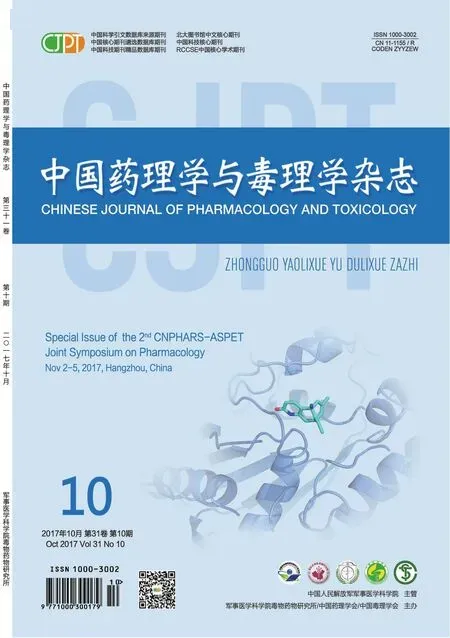Identification and optimization of a potent and highly selective D3 dopamine receptor agonist
Amy E MORITZ,R Benjamin FREE,Warren WEINER,Muzna BACHANI,Trevor DOYLE,Noel SOUTHALL,Marc FERRER,Jonathan A JAVITCH,Joseph STEINER,Ara ABRAMYAN,Lei SHI,Jeffrey AUBÉ,Kevin FRANKOWSKI,David R SIBLEY
(1.Molecular Neuropharmacology Section,National Institute of Neurological Disorders and Stroke,National Institutes of Health,Bethesda,MD,20814;2.University of North Carolina,Chapel Hill,NC,27599;3.Neurotherapeutic Development Unit,National Institute of Neurological Disorders and Stroke,National Institutes of Health,Bethesda,MD,20814;4.National Center for Advancing Translational Sciences,Rockville,MD,20892;5.Columbia University,New York,NY,10032;6.Computational Chemistry and Molecular Biophysics Unit,Molecular Targets and Medications Discovery Branch,National Institute on Drug Abuse,National Institutes of Health,Baltimore,MD,21224)
T1 MOLECULAR PHARMACOLOGY AND DRUGDISCOVERY
T1-1
Identification and optimization of a potent and highly selective D3 dopamine receptor agonist
Amy E MORITZ1,R Benjamin FREE1,Warren WEINER2,Muzna BACHANI3,Trevor DOYLE1,Noel SOUTHALL4,Marc FERRER4,Jonathan A JAVITCH5,Joseph STEINER3,Ara ABRAMYAN6,Lei SHI6,Jeffrey AUBÉ2,Kevin FRANKOWSKI2,David R SIBLEY1
(1.Molecular Neuropharmacology Section,National Institute of Neurological Disorders and Stroke,National Institutes of Health,Bethesda,MD,20814;2.University of North Carolina,Chapel Hill,NC,27599;3.Neurotherapeutic Development Unit,National Institute of Neurological Disorders and Stroke,National Institutes of Health,Bethesda,MD,20814;4.National Center for Advancing Translational Sciences,Rockville,MD,20892;5.Columbia University,New York,NY,10032;6.Computational Chemistry and Molecular Biophysics Unit,Molecular Targets and Medications Discovery Branch,National Institute on Drug Abuse,National Institutes of Health,Baltimore,MD,21224)
OBJECTIVEDopamine receptors(DRs)are involved in the development and treatment of many neuropsychiatric disorders.Currently available dopaminergic drugs modulate both DRD2 and DRD3,leading to side effects and uncertainty as to the roles each DR subtype plays physiologically.Our lab employed high throughput screening paradigms to discover highly selective modulators for the DRD3.METHODSThe NIH Molecular Libraries Program 400,000+small molecule library was screened using the Discove RxPathHunter®β-arrestin assay for compounds that activate the DRD3 without effects on the DRD2.Confirmation and counter-screens assessed selectivity and mechanisms of action.We identified 62 potential agonists,and chose the most promising to perform a structureactivity relationship(SAR)study to increase potency while maintaining selectivity.The lead compound identified through this process,ML417,was also characterized using bioluminescence resonance energy transfer(BRET)-based β-arrestin recruitment and G-protein activation assays as well as p-ERK assays.Potential neuroprotective properties of this compound were assessed using a SHSY5Y neuronal cell model.RESULTSML417 displays potent,DRD3-selective agonist activity in multiple functional assays.

Assay DiscoveRxβ-Arrestin β-Arrestin BRET Go BRET p-ERK D3EC50(n≥4)(36.00±5.60)nmol·L-1(1.20±0.50)nmol·L-1(0.21±0.16)nmol·L-1(21.00±6.60)nmol·L-1D2EC50(n≥4)>10,000 nmol·L-1>10,000 nmol·L-1>10,000 nmol·L-1>10,000 nmol·L-1
Binding and functional GPCR screens(>165 receptors)show ML417 has limited cross-reactivity with other GPCRs.ML417 also displays superior(compared to the reference compound pramipexole),dose-dependent protection against a decrease in neurite length induced by 10 μmol·L-1of the neurotoxin,6-hydroxydopamine,in the SHSY5Y cell model.CONCLUSION We have discovered and characterized ML417,a potent and highly selective DRD3 agonist.This compound will be useful as a research tool,and may prove useful as a therapeutic drug lead.
Dopamine receptor;high throughput screening;subtype selectivity;neuroprotection
The project supported by National Institute of Neurological Disorders and Stroke Intramural Research Program
David R.SIBLEY,Tel:301-496-9316,E-mail:sibleyd@ninds.nih.gov
- 中国药理学与毒理学杂志的其它文章
- Protective role of FoxO transcription factors against oxidative stress-induced chondrocyte dysfunction:a new therapeutic target for osteoarthritis
- Meta-analysis of serum copper and heart failure
- Involvement of cysteinyl leukotriene signaling in microglial morphological changes and CASP1 expression in vitro
- Inhibitory effect of compound NS5806 on cardiac transient outward potassium channel dependents on interaction between auxiliary subunits
- Connexin 40-formed GJIC increases the phototoxicity of photodynamic therapy through ROS-and calcium-mediated pathways
- Specific role of synovial macrophages in rheumatoid arthritis

